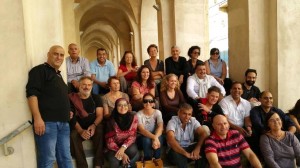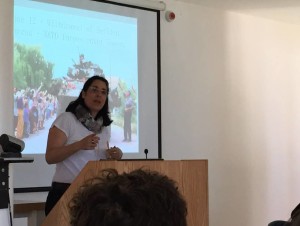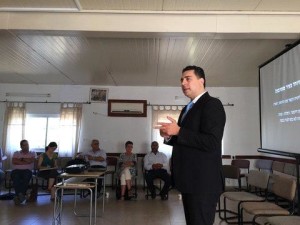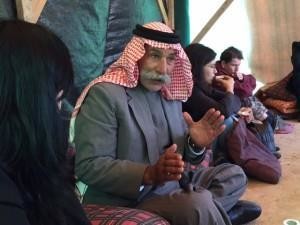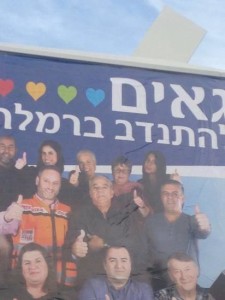Building Leadership in Mixed Cities
In Israel there are seven cities where Jews and Arabs live in close proximity but rarely mix. These cities present special challenges, especially in times of tension. This spring, the School for Peace launched for the first time, an innovative leadership program for 30 leaders and activists from mixed cities throughout Israel. The goal was to help participants address the needs of their cities and begin to transform these cities into shared communities.
The Israel Central Bureau of Statistics defines: Acre (27.2% Palestinian-Israelis), Lydda (Lid/Lod) (24.4%), Ramleh/Ramla (22.5%), Haifa (10%), Jaffa (31.2%), Nazareth-Illit/Upper Nazareth (14.5%) and Ma’alot-Tarshiha (22.1%) as mixed cities. Aside from Nazareth-Illit and Tarshiha-Ma’alot, the situation in these cities is a direct outcome of the 1948 war. Today the Palestinian populations in these cities are made up of four groups: pre-1948 residents, refuges from neighboring villages and cities, Bedouins, and after 1967 Palestinian collaborators from the West Bank and Gaza. The Jewish populations are primarily poorer immigrants from the 1950s onward. This School for Peace program addresses conflicts in local civil society and around the world, presenting sustainable solutions and models of conflict management at the micro and macro level.
The program provides an opportunity to establish a dialogue between participants who are in leadership positions in Israel’s mixed cities; to create working relationships; strengthen leadership qualities; and promote peace and equality in these communities. The program brings to the forefront the extensive knowledge of the participants and emphasizes joint projects for social change. Projects focus on creating and managing shared spaces for Arabs and Jews in mixed cities; creating a sense of shared security and joint ownership of public spaces; and enhancing networking between concerned citizens in mixed cities. Through this we wanted to build a group committed to raising its voice and taking action upon incidents of racism and violence; a group willing to provide an effective and functional response, handling incidents before they escalate. Participating in the program was an equal number of Jews and Arabs from the mixed cities of Ramla, Lydda, Beersheba, Haifa, Acre, Jaffa and Nazareth.
In February 2015 the School for Peace opened a course for leadership and activism in shared/mixed Arab and Jewish cities. This program lasts for 12 months and began with a three-day opening workshop in Wahat al-Salam ~ Neve Shalom, which was followed by monthly six-hour meetings held on Fridays. The program includes study tours in the field and an end of the year two-day closing workshop in Wahat al-Salam ~ Neve Shalom.
Following the initial three-day opening workshop, the program continued on the 20th of March 2015 with a lecture by Prof. Haim Yacobi of the Ben Gurion University who spoke on multiculturalism, nationality and the politics of mixed cities. After the lecture the group had 2 dialogue sessions on multiculturalism.
On April 17th the group met at Wahat al Salam- Neve Shalom to hear a lecture by Dr. Roly Rosen from Shatil, the New Israel Fund Initiative for Social Change, on the reality and vision of mixed cities. Dr. Rosen, a graduate of the School for Peace’s first facilitators course, wrote the book “Haifa between Reality and a Vision for a Shared City”, focusing on how to transform a mixed city into a city for all its citizens with equal rights and equal access for all.
On May 1st, “International Workers’ Day”, the Mixed Cities and Architects, Planners and Engineers programs met together and heard two lecturers who spoke about the dilemmas of mixed cities in times of conflict and post-conflict realities in other places in the world. Professor Leslie Schwartz, from Stellenbosch University in Cape Town, South Africa spoke about Cape Town and the dilemmas faced in transitioning into a city for all its residents. Dr. Orly Friedman, from Belgrade, spoke about the dilemmas of coexistence in cities that have had bloody wars. After the lectures the participants split into region-based groups in order to broaden their network of connection and understanding of issues in different mixes cities. The groups began to develop ideas for joint projects to bring about change in the cities and regions where they live and work. Ghasan Monayer, from the mixed cities course, presented the problems of a proposed city plan for Lydda that does not take the Arab community into account. In Lydda there are 82,000 residents, of them 71.6% Jewish and 28.4% Arab. The planners from the Tel Aviv Municipal Council, the Arab Center for Alternative Planning, and others offered to look at the proposed plan and contribute their professional recommendations for changes.
On May 15 the group organized a meeting in Jaffa to commemorate Nakba Day. Tom Weisel, a Jewish participant in the program, prepared an exhibition of photos and text on the Nakba and participants shared stories of their families’ experiences during that period of history.
In June the group met with Professor Gadi Algazi who presented a historical and contemporary analysis of the Jewish Palestinian conflict and the current situation. The group talked about the possibilities for combating the ongoing displacement of Arabs in mixed cities. After the lecture, participants formed three groups to discuss possible projects. Some ideas included: establishing a parliament of young Bedouins in Southern Israel; organizing an exhibition in Jaffa to perpetuate its Palestinian heritage; and developing a creative way to address Yom Kippur, the Jewish Day of Atonement, and Eid al-Adha, the Muslim celebration which fell on the same date this year. This group developed an educational kit to be used in schools in mixed cities. Additionally, since the group was very active outside the official sessions, they formed a ‘WhatsApp’ group to continue their dialogue between meetings.
On Friday July 24 the SFP convened the sixth meeting of the program. At the meeting, Att. Kais Nasser gave a lecture on legal aspects affecting the Arab population in mixed cities: processes of dispossession, destruction and gentrification. Nasser presented examples from cases he had handled. The lecture was reported on the popular Al-Arab news site that serves the Arabic Speaking population.
The mixed cities program carried out three field visits. The first was in Nazareth, where the new city of Nazareth-Illit is slowly encroaching on the historical Christian City of Nazareth. Many Arab families are moving to Nazareth Illit, however the city services are not inclusive. Nazareth director of education Samia Basul discussed with the group the issue of education and the complexities of the Arab citizens of Nazareth-Illit needing to utilize the Nazareth school system as there are no schools in Nazareth-Illit that are part of Israel’s Arab Education System.
Program participants from Jaffa organized a tour for the group in that neighborhood. The group visited the Mishlama-project, a special office of the Tel Aviv-Jaffa Municipality, which is responsible for coordinating between Jews and Arabs and addressing the special problems of the community. The group also visited the Hand in Hand bilingual kindergarten, which is initiating a mixed Jewish and Arab school in the community. Sami Abu Shadeh, a Palestinian Israeli political activist, tour guide and expert of Jaffa’s history, lead the tour and discussed the demographic shifts of the population in Jaffa during the Nakba and today as the community is facing the harsh realities of gentrification.
The final field visit, on December 18th, was organized by participants from the south of Israel. Veronica Vigdorchik, project manager at AJEEC-NISPED – Arab-Jewish Center for Equality, Empowerment and Cooperation – Negev Institute for Strategies of Peace and Development, spoke about their programs in the Negev. Professor Yiftachel lectured on the dispossession of the Bedouin in the south, and the group visited the destroyed village of El Arakib where Sheikh Al Towy spoke about his village. The village was uprooted and destroyed several times by the State. The group then traveled to the Bedouin City of Rahat. There Jamal Al Karani, a member of the program who runs the NGO – New Dawn In the Negev, a Bedouin-Jewish organization promoting equality, coexistence, and peace among all residents of the Negev, talked to the group about the unique challenges of the Bedouin in the Negev and the activities of the NGO.
The final meeting of the program was a weekend held in January at WAS-NS. The meeting was opened with a lecture by Professor Esther Herzog on gender issues and leadership in mixed cities. In the afternoon there was a skills training workshop given by the Shatil organization. There was a session on lobbying and one on fundraising. After, participants discussed with the group the projects they have begun as a result of the program.
In the evening there was a ‘playback theater activity’, led by SFP’s graduate and psychotherapist, Eva Miller.
The final day was devoted to summarizing the course in uni-national and bi national groups and participants filled out evaluation questioners. In general, the participants expressed satisfaction with the program. They thought that the training workshop with Shatil should have come earlier in the program. They thought that the educational field trips greatly contributed to their understanding of the situation in the field. The lectures that presented situations in other parts of the world were very informative and the participants wanted to hear more about how issues were being addressed in other places. In the projects that the participants carried out, they wanted more advice and mentoring.
The group, on their own, initiated a follow-up meeting in the north and their ‘whatsapp’ group is very active.
Selected Projects Initiated by Participants
Recognizing the Other: An Exhibit Acknowledging the Suffering of the Victims of the 1948 War: This educational exhibit was designed by Tom Wiesel and acknowledges the role of Israel and the Jewish people in the Nakba of 1948. The exhibit was developed as result of the educational process that the Jewish participants experienced at Wahat al Salam – Neve Shalom. It gives expression to the many different narratives of Israel’s independence, deepening the ability of the Jewish people to understand the suffering the Palestinians experienced during the establishment of the State. This exhibit seeks a common meeting point of understanding and shared society. It will be displayed in various educational institutions.
Centennial Celebration of Jamal Basha Elnozahh Street in Jaffa: This project is being run by Safa Yunes, Ibrahim Agbarhea, Tom Wiesel, and Ahmad Balaha. The main street in Jaffa, now called Jerusalem Blvd., was established 100 years ago and has served as the center of the Palestinian community from the beginning of Ottoman rule. This project celebrates 100 year since the establishment of Jamal Basha Elnozahh Street, strengthening the Arab history and heritage of Jaffa and promoting shared community. This project includes: putting up signs in Hebrew and Arabic designating historic spots along the street with a brief history; developing an exhibit of social, cultural, and architectural life in the community; producing a documentary video with the people who originally lived along Elnozahh Street; guiding tours for school children in the neighborhood emphasizing the community’s history; guiding tours in the community for the Jewish and Arab public.
Youth Parliament in the Negev. This project is being run by Jamal El Karnawi, Niva Reem, Veronica Vigdortchik, and Adv. Khalil Asana. The Negev region of Israel is made up of Bedouin and Jews who rarely if ever meet. This project brings together Bedouin and Jewish youth aged 18-25, from the Negev, to meet together on equal ground, 10 times during the year. The youth listen to a panel of lecturers who present on various topics followed by a discussion between the youth. The goal is to solidify a group of youth from the region who have similar ideas and are interested in working together. The program will be organized and managed by the non-profit “A New Dawn in the Negev”.
Solutions for Parenting in the Modern World: A Joint Framework for Jewish and Arab Women. This program is proposed by Paula Silberstein-Melamed, senior educational and child developmental psychologist. Jewish and Arab women, citizens of Israel, are given the opportunity to learn together one of the latest systems to improve parenting skills through a 15 session course to be held in groups of 12-15 women. The groups are led and coordinated by professional co-leaders, one Hebrew speaker and one Arabic speaker. It is based on the book The Whole-Brain Child 12 Revolutionary Strategies to Nurture Your Child’s Developing Mind, by Dr. Dan Siegel and Tina Payne Bryson and contributes to understanding and techniques that help parents survive everyday parenting challenges and helps the family thrive. As part of this project, it will be translated into Hebrew and Arabic. In each session, except for an opening, an intermediate, and a closing session, a chapter of the book is taught, and the women will bring personal dilemmas to the group. The problems are analyzed and discussed by the participants, with the help of the professional coordinators.
Mixed City – Improving Jewish-Palestinian Relations in the City of Lydda. This project was proposed by Monayer Gassan, who is going to be a city council member. The project brings together four Arab city council members of the City of Lydda, and as many Jewish city council members as possible for a weekend seminar at Wahat al Salam – Neve Shalom. The goal is to begin informal planning discussions in a non-threatening atmosphere and to reach agreements that will affect the allocation of resources to the Arab residents of Lydda. Specific issues to be focused on include: housing, building, tearing down of housing units, and more. The objective is to improve relationships between the polarized populations and to change the underlying tensions between Jews and Palestinians in the city. The idea of the project was presented to the mayor of the city who supported the idea. We are continuing to finalize the planning of this seminar and seeking official approval from the mayor and city council.
Training to Advance Pluralism and Equality. This project is run by Michal Kaidar from Dror Israel the Center for Shared Living in Acre. It puts together a number of groups in workplaces and/or businesses in the mixed city of Acre. The focus of these groups is to strengthen shared society, democracy, and a commitment to making Acre a city of, and for all of its citizens. Workplaces willing to take part in this project are identified, and groups of 8-20 employees are established. These groups meet, and, through ‘outdoor training’ workshops and discussions explore the character of the city; issues of shared society in the city; and the needed expressions of democracy in a civil society. The group then develops programs to strengthen these values. They implement these emphasizing the unique aspects and needs of Acre and its citizens.
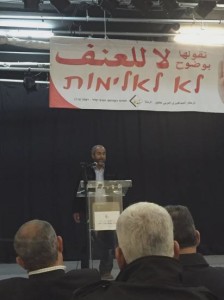
Course Participant, Mr. Amer Abu Ganem, Member of City Council from the Islamic Party in Ramla Lecturing Against Violence
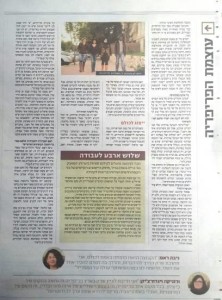
Article in Local Paper with Participants Niva Reem, Veronica Vigdorchik, on the organization they founded, “The Periphery”, which is advancing the rights of the people in the periphery.
Participants’ Feedback
N: (Jewish woman – director of an association for Jewish-Arab dialogue in the south) I have decided that this work is my calling and the course really strengthened this. I have met interesting people here. When I look back on things I did this year, suddenly I see them in the context of peace. I have been disappointed by Meretz [political party]. What I learned here I have brought into every aspect of my life. I decided that I would not by afraid anymore [to take a stand in public]. Today I am more committed to peace. One of the gifts of the program has been the great people I’ve met. It has been a difficult year [in Israel-Palestine], I often thought about what was happening to the Arab participants. It has been good to see and understand their points of view.
R: (Arab man – city council member and political activist) This workshop made me happy since it made me realize that there are people of this quality. We live with Jews but differently. Here we came together as a group and it would be a shame if we stopped our activities together. It is not easy for the Jewish group to talk and hear about the Nakba and the occupation. However, the project T did showed that he can understand, recognize and connect with our reality. We need to utilize what we have achieved to advance something even greater.
S: (Arab woman – head of non-profit and social activist) I have been in a lot of groups for Arab and Jewish women. This one was very different. As a Palestinian, I heard things I hadn’t heard before. The visit to El Arakib was interesting and new for me. It was very comfortable and easier because my culture was understood.
T: (Jewish male – social activist) I came as a Zionist and am leaving as a Zionist. In order for Zionism to be what it should be we can’t be violent and the life of one person can’t be on account of the life of another. I learned to listen here. I feel good because I was able to express what I felt and be who I am. It allowed me to listen to others. There were disagreements on methods but when people want to meet it is significant and it changes their world: it turns ones life upside down and that is amazing. I have made new friends. I hope that we will continue to do things together.
M: (Arab male- head of peace organization) I went through an interesting process during the program. I feel like previously I wasn’t really connected to my Palestinian identity. The idea of a mixed city and the destruction of houses is something that I didn’t know about. Before I felt like I had to think about everything I wanted to say and not to think as an Arab. Through the program I slowly learned how to express my opinion and not be afraid.
A: (Arab male – member of city council in one of Israel’s mixed city) If I hadn’t been exposed to the various ideas and points of views in this program I would have stayed in my own bubble. The program pushed me to get to know people who can be helpful in the future. When the program ends we will become ambassadors bringing forth the idea that through change their will be a better future for everyone. The program brought us together in a group that represents everyone in the society. We have become like a family.


